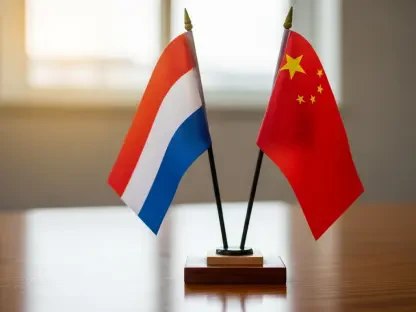Government subsidies for large manufacturing firms have become a topic of heightened interest due to recent global challenges such as the climate transition, the COVID-19 pandemic, and rising geopolitical tensions. These factors have spurred concerns about supply chain resilience and fair competition, prompting a renewed focus on industrial policies. A crucial aspect of these policies is the distribution and impact of government subsidies on manufacturing firms, which is meticulously detailed in the OECD MAGIC database.
The primary challenge in assessing these subsidies lies in the lack of reliable, comparable data across different countries and over time. This challenge arises from both methodological difficulties in quantifying government support and the reluctance of certain governments to fully disclose their support measures and associated costs. The OECD Manufacturing Groups and Industrial Corporations (MAGIC) database aims to bridge these gaps by providing detailed, confidential firm-level data on subsidies received by the world’s largest manufacturing firms, thus offering unprecedented insights into this complex issue.
A Comprehensive Database for Enhanced Insight
The OECD MAGIC database provides a comprehensive view of the types and amounts of government support received by major manufacturing players globally, covering 482 firms across 14 key sectors between 2005 and 2022. These firms, selected based on their size, collectively represent at least two-thirds of global sales or capacity in their respective sectors, ensuring that a significant portion of the global manufacturing landscape is analyzed. This extensive coverage allows for a robust examination of industrial subsidies.
The database categorizes government support into three primary forms: grants derived from corporate disclosures, corporate income tax concessions reflecting tax savings due to specific tax code provisions, and below-market borrowings indicating differences between actual and hypothetical benchmark interest rates. This categorization enables a detailed analysis of the various mechanisms through which governments support their domestic industries. By capturing these three primary forms of support, the OECD MAGIC database provides a comprehensive and nuanced understanding of how subsidies are distributed and utilized within the manufacturing sector.
Firm-Level Focus and Transparency
One of the most notable aspects of the OECD MAGIC database is its focus on firm-level data. This granular approach allows for the identification of subsidies in less transparent jurisdictions and at various government levels. Additionally, the database captures subsidies funneled through intermediary state enterprises, such as state banks, which other methodologies might overlook. This firm-level granularity is a significant advantage over datasets that rely solely on public information and government disclosures.
In contrast to approaches like the New Industrial Policy Observatory (NIPO) dataset, which identify subsidies from the perspective of the subsidy-providing authorities and rely heavily on governments to provide comprehensive public information, the OECD MAGIC database adopts a bottom-up approach. This approach reveals a more detailed and inclusive picture, especially in analyzing support mechanisms in opaque environments. By focusing on firm-level data, the OECD MAGIC database offers a clearer and more accurate representation of government subsidies, uncovering support that might otherwise go unnoticed.
Prevalence and Magnitude of Subsidies
The prevalence of subsidies among large industrial producers is significant. Most firms in the OECD MAGIC database received at least one type of government support for half or more of the observed period, highlighting the widespread nature of government intervention in the industrial sector. This widespread prevalence underscores the importance and impact of subsidies in shaping the competitive landscape of global manufacturing.
While the median subsidy is relatively modest, at 0.6% of revenue, there are notable instances of substantial subsidies, sometimes exceeding 15% of revenue. These large subsidies are particularly prevalent among firms in China within industries such as aluminum, cement, glass, and semiconductors. The substantial financial support received by these firms can significantly impact their competitiveness on the global stage, allowing them to achieve economies of scale and strategic advantages that can influence market dynamics.
Subsidy Types and Firm Characteristics
The analysis of the OECD MAGIC database reveals that subsidies are generally larger in relation to firms’ investment in fixed tangible assets, indicating a focus on supporting capital-intensive industries. Firms based in China receive higher subsidies on average, particularly through below-market borrowings, which are prevalent in capital-intensive industries. This focus on capital-intensive industries reflects the strategic goals of different national policies aimed at promoting long-term industrial growth and global competitiveness.
Chinese firms, in particular, benefit from significant government support, which enables them to achieve economies of scale and competitive advantages in global markets. This pattern of substantial subsidies raises important questions about fair competition and the long-term sustainability of such extensive support mechanisms. The strategic allocation of subsidies to capital-intensive industries suggests that governments are targeting sectors that can drive substantial economic growth and technological advancement.
Market Dynamics and Changes
Market dynamics reveal that while the market shares of the largest firms tend to remain stable, there are instances of significant shifts driven by government subsidies. China-based firms, in particular, have experienced more frequent market share gains, often at the expense of firms based in OECD countries. These shifts highlight the substantial impact of government subsidies on global competitive landscapes, influencing the distribution of market power across different regions.
Significant market position gains for China-based firms are observed in sectors such as solar photovoltaic cells, shipbuilding, telecommunications network equipment, and aluminum. Many of these gains occur within domestic markets, supported by targeted industrial strategies that leverage government subsidies to enhance competitive positioning. This sectoral analysis indicates that government subsidies can be a powerful tool for driving industrial growth and reshaping competitive dynamics.
Limitations and Areas for Improvement
Despite the extensive data hosted in the OECD MAGIC database, it has its limitations. It mainly covers the largest firms in select sectors, leaving out smaller companies and a range of other industries. This exclusion limits the database’s comprehensiveness. The database also does not provide detailed information on the policy objectives or the design characteristics of the subsidies, which hinders the ability to evaluate the targeted impact of specific government support measures. Additionally, it doesn’t account for other forms of government aid, such as differential regulatory treatments, export restrictions on raw materials, and energy inputs priced below market rates.
Future work with the OECD MAGIC database aims to overcome these limitations. Plans include broadening the scope of data, refining the range of support instruments captured, and offering econometric analyses on the effects of subsidies on firm productivity, investments, and changes in market share. These initiatives intend to provide a deeper understanding of how government support mechanisms influence the global industrial economy.
In summary, the OECD MAGIC database has made significant strides in enhancing the understanding of industrial subsidies, especially for large manufacturing firms. It sheds light on the disparities in subsidy distribution across different regions and sectors, revealing the intricate nature of such support mechanisms. Ongoing improvements and expansion of the database will lead to a more nuanced understanding of the impact of government subsidies on global industrial dynamics, thereby enriching policy debates and academic research.









